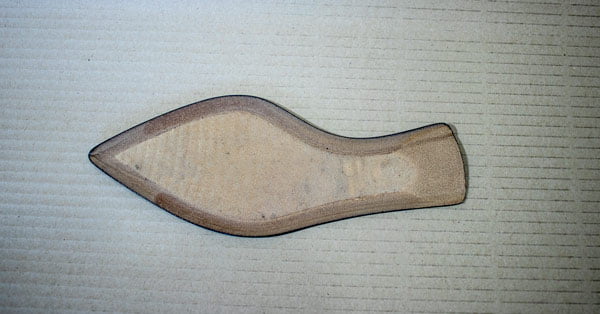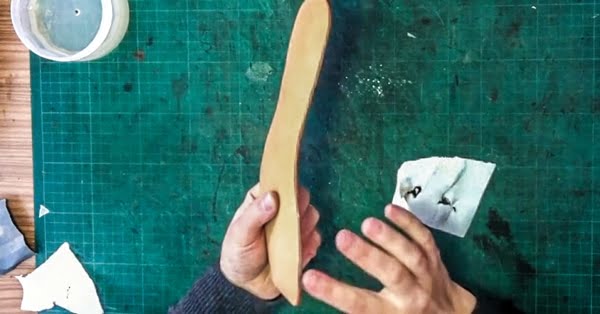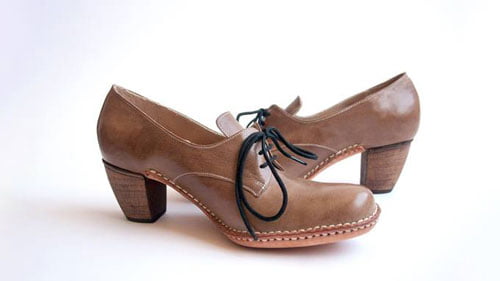The best shoe sole making techniques I will talk about here are the most common and most beautiful sole constructions every beginner in shoemaking can do working with leather.
There are many other possible shoe making techniques, of course, that you can use in making your shoes but I chose these 6 sole making constructions because most of them don't require any special shoemaking tools. Also, to make soles for your shoes following these sole making constructions you will need to work with vegetable-tanned leather, and this material is very easy to source online or locally.
If you want to learn more about different vegetable-tanned leather types and how we use them in shoemaking, make sure to check this post “Best Leather Types For-Beginners in Shoemaking”
6 Best shoe sole making techniques

We actually can divide most of the sole making techniques into 2 types: shoe soles with cemented construction and stitched shoe soles.
Let’s start first with cemented shoe soles. Shoe soles with cemented construction are soles that we attach simply with cement (contact leather glue) to the shoe bottom.
Most of the shoe soles in shoemaking are made with this cemented construction.
In general, there are 4 types of the cemented shoe soles.
1. Perfect shoe soles for beginners or alternative technique of sole making

I call this sole making technique a perfect one because every beginner in shoemaking can make it without any special shoemaking tools. I invented this technique especially for my students and it is an alternative way to build beautiful and comfortable shoe soles like a pro. If you want to see some works of my students, you are wellcome to visit this page:"Students make shoes".
Here are the main steps of this technique:
-You should flatten the shoe bottom with a cork filler and make the entire surface smooth
-Make a pattern of the sole following the edge of the lasted upper
-Cut out leather (sole bend) using this pattern
-Skive the sole edge (2-3mm thickness)
-Make a finishing of the edge before you will attach it to the shoe bottom

I teach this sole construction in one of my constructible courses “Creating Alternative Bespoke Outsole Course”
Also, I teach this approach together with different sole finishing techniques and different sole making techniques working with variety of shoe materials at my 1-Year Shoemaking Program.
2.Traditional sole making technique
As you can understand from the name of this shoe type it is 100% the traditional sole making technique that exists in shoemaking from the beginning of this craft.
The biggest difference from the first type is that it comes bigger than the shoe bottom and the extra of it must be cut after attaching to the shoe bottom.

So main steps of this sole construction:
-You should flatten the shoe bottom with a cork filler and make the entire surface smooth
- Make a pattern of the sole following the edge of the lasted upper plus an extra 7-8mm
-Cut out leather (sole bend) using this pattern
-Skive the sole edge (2-3mm thickness) and if you want to learn moreabout skiving technique, read this article with free shoemaking tutorial: "How to skive leather in shoemaking".
-Attach the sole to the shoe bottom and cut the extra
Then the raw and flashy edge of this shoe sole must be smoothened with a special shoemaking tool.
Ah, by the way, the extra sole edge you can cut also with the use of a special lip knife. It will protect the leather upper from scratching.
There was a very short explanation of this approach but full step by step traditional sole making technique you can learn in one of my courses, for example, “T strap pump shoe course”.
This approach requires experience, so if you have some leather skins that you don’t mind ruining, you can try to use this technique in making your shoes.
3. Elegant shoe sole technique with heels

This type of shoe sole you need to build when you work with heels the inner part (heel breast) of which must be covered with the sole. So the entire shoe sole includes the part of the shoe bottom and the part of the heel.
To create this elegant shoe sole you can use one of the shoe making methods I listed above. And this specific ellegant shoe sole making technique where the sole tcomes together with heels , I teach in "Slingback Pump Shoes Course".
The main step here is to skive well this part of the shoe sole that covers the heel breast.
4. Making sole with “Fake” welt

There is a real welted shoe sole construction ( we will talk about this shoe sole construction later in this article), and there is a “fake” welted construction that imitates the real one.
This sole making technique is very simple and almost doesn’t require any special tools and skills.
To make this sole type you need to attach a ready-made leather strip (welt) to the shoe bottom and then you need to attach the leather sole.
The sole must be bigger than the shoe bottom and then extra of the sole edge we need to cut out and finish this edge to make it look smooth and shiny.
This sole making technique is one of the easiest way to create beautiful shoe sole for beginners in shoemaking. In this atrial "4 Design Solutions That Will Make Your Shoes Look Better" you can learn what are most common mistakes beginners in shoe making do and what are the solutions. So this sole making technique is one of possible solutions in making shoes without mistakes.
I teach how to create this shoe sole type in my “High heel Pump Shoes”, "Sneakers making course" and "Loafers making course".5.“Opanka” shoe sole technique
This is Italian shoe sole construction where the edge of the leather shoe sole overlaps the beginning of the upper and must be sewn to the upper through all layers of the shoe. That’s why opanka shoe soles last for a long time.

Here are the main steps of opanka making technique:
-You should flatten the shoe bottom with a cork filler and make the entire surface smooth
- Make a pattern of the sole following the edge of the upper plus an extra 1-1.5 cm.
This extra will overlap the upper.
-Skive the edge and place it on the shoe bottom
-Sew the edge of the shoe sole to the upper
Here you almost don’t need to use contact glue, you sew the entire shoe sole to the upper. This is one of the benefits of this sole making technique that you will use a glue a little.
I personally like this shoe sole technique and you can learn it in my ”Bespoke Derby Opanka shoe course”.
6. English welted shoe sole making technique
English welted shoe sole construction is the construction where all parts of the shoe are sewn together: insole, upper and lining, stiffeners, and shoe sole.
Here we really sew the welt to the insole and upper unlike in the “fake” welted shoe sole technique I talked about in the beginning of this post.

This sole making technique is the hardest among all other techniques listed previously and requires some experience in shoemaking.
This construction is very solid and lasts for a long time.
It is a pretty complicated technique and we teach it in my “Bespoke English welted oxford Shoe course” but I want to show you briefly the main steps:
-Make a holdfast in the leather insole before you go to last the upper.
The holdfast is a kind of wall inside the leather insole with the holes that you need to create.
Through these holes, you will sew upper to the insole.
-Prepare the welt and if you want to learn on how to make a real leather welt, make sure to see this tutorial "How to Make Shoe Welt".
or use a ready-made one and sew it to the upper and insole
-Flatten the shoe bottom with the cork or some leather piece
-Attach the shoe sole and sew it to the welt


These were the main sole making techniques where we make soles from vegetable-tanned leather. The primary idea of this post is to show you the variety of sole making techniques that you can use in making any footwear type. You can choose the best one that suits the entire shoe design idea you have.
In general, to design any footwear type and to make a pattern of this design you need to know rules of constructions of all existing footwear types but if you want to learn a short cut system I developed, you are welcome to check out my "Footwear design course".
To make all these types of the shoe soles you will need to use different shoemaking tools and materials and if you want to learn more about it, check this post "Beginners Shoemaking Tools and Materials: The Definitive Guide 2019". Also, if you are interested in learning shoemaking and want to learn deeper about entire process of making shoes, you are welcome to read this post "How to Make Shoes: The Definitive Guide".
So, watch the tutorial atthe beginning of the article with the explanation about all these techniques of sole making.


Good Morning Sveta!! I sure would like to know how to make white fabric insoles. Can you help me learn how to make them? I want to make them strong so they don't tear, rip or ball up after a year of wearing.
I want continue ur sole making online course. Please reply. To me